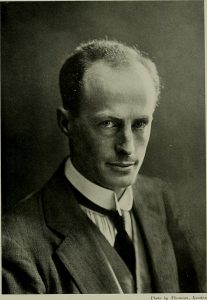SIR DOUGLAS MAWSON (1882–1928)
 Douglas Mawson is one of Australia’s best-known Antarctic explorers. Born in England but raised in Australia, he gained degrees in mining engineering and geology and became a lecturer in minerology and petrology at the University of Adelaide in 1906. He explored particularly hostile regions of East Antarctica, and contributed much to scientific understanding of the continent.
Douglas Mawson is one of Australia’s best-known Antarctic explorers. Born in England but raised in Australia, he gained degrees in mining engineering and geology and became a lecturer in minerology and petrology at the University of Adelaide in 1906. He explored particularly hostile regions of East Antarctica, and contributed much to scientific understanding of the continent.
NIMROD EXPEDITION (1907-1909)
Mawson’s first experience of Antarctic exploration was as physicist with Shackleton’s Nimrod expedition. While Shackleton was preparing for his push toward the South Pole, the twenty-five-year-old scientist was part of the party which made the first ascent of Mount Erebus. On reaching the summit, Mawson calculated the depth and width of the crater.
Afterwards, in 1908, Mawson joined his mentor Edgeworth Davis and others on a scientific mission to reach the south magnetic pole. Setting off initially by automobile for a few miles, they then man-hauled sledges for 200 miles (322 km) over sea ice, before turning inland into the mountains. Surviving snow blindness and falls into crevasses, they finally arrived at the South Magnetic Pole on a plateau at 7000 feet (2134 m), with the realization that it was a moving point unlike the Geographic South Pole. Their remarkable sledge journey lasted for 122 days (although they only had food only for 93), covered 1260 miles (2028 km) of unexplored territory, mapped a vast previously unexplored area of South Victoria Land and made great geological advances.
AUSTRALASIAN ANTARCTIC EXPEDITION (1911-14)
In 1911 Mawson returned to Antarctica as leader of his own expedition. No-one had been ashore on the coastline directly south of Australia so, having acquired the Aurora as his expedition ship, he landed two parties 1500 miles (2144 km) apart. The party led by Mawson established a base at Cape Denison in Adélie Land, at what was to become Commonwealth Bay, while Frank Wild’s party landed at the Shackleton Ice Shelf. The appalling weather conditions on this coastline were previously unknown and Mawson’s account of the expedition ‘Home of the Blizzard’ graphically describes the snowdrifts and winds in excess of 186 miles per hour (300 kilometers per hour) that they regularly endured. One depot party was stranded for 17 days in a storm.
The following season Mawson sent out several mapping parties by dogsled. Mawson led the Far Eastern Party with two companions, Belgrave Ninnus and Xavier Mertz, and 16 dogs. They set off on November 10, 1912, aiming to reach the same location he had approached from the east four years earlier. After several narrow escapes, a heavily-laden sledge disappeared into a crevasse, taking with it one of the men, ten of the strongest of the dogs, the tent and most of the food. Mawson and his remaining companion Xavier Mertz attempted to return to base at Cape Denison 501 km (311 miles) to the west, but without adequate equipment or food. Facing starvation, illness and snowblindness, they sacrificed the remaining dogs one by one, Mertz quickly weakened and, despite Mawson’s efforts, tragically died. Mawson’s month-long battle to make his way back to Cape Denison over the remaining 100 miles (160 km) is one of Antarctica’s truly epic survival stories.
The ordeal was not over when Mawson arrived back to the Cape Denison hut. The Aurora had waited for his return, but that morning had reluctantly left to collect Frank Wild’s party before winter conditions made it impossible. The five men who had volunteered to stay behind to search for Mawson’s party desperately radioed the ship to return, but Captain Davis made the difficult decision to leave them behind for another winter, rather than risk the ship and the rest of the expedition by returning.
AFTER THE EXPEDITION
Mawson was celebrated on his return to Australia. He married his fiancée Paquita Delprat and soon embarked on a lecture tour of Europe and the United States to pay off his debts and for publication of his scientific papers. While in England, he was knighted by King George V. Afterwards he returned to the University of Adelaide, becoming professor of Geology and Minerology in 1921.
BANZARE
The British, Australian and New Zealand Antarctic Research Expedition (BANZARE) was a response to increased whaling in Antarctic waters; the 1924 French claim to Adélie Land; and the question of territorial rights in Antarctica. Over 1929-30 and 1930-31, a team led by Mawson and including John King Davis and Frank Hurley used Scott’s old ship Discovery to carry out research, but also to lay claims to extensive areas of Antarctic territory.
Mawson retired from his academic position in 1952, and died at the age of 75 in 1958.